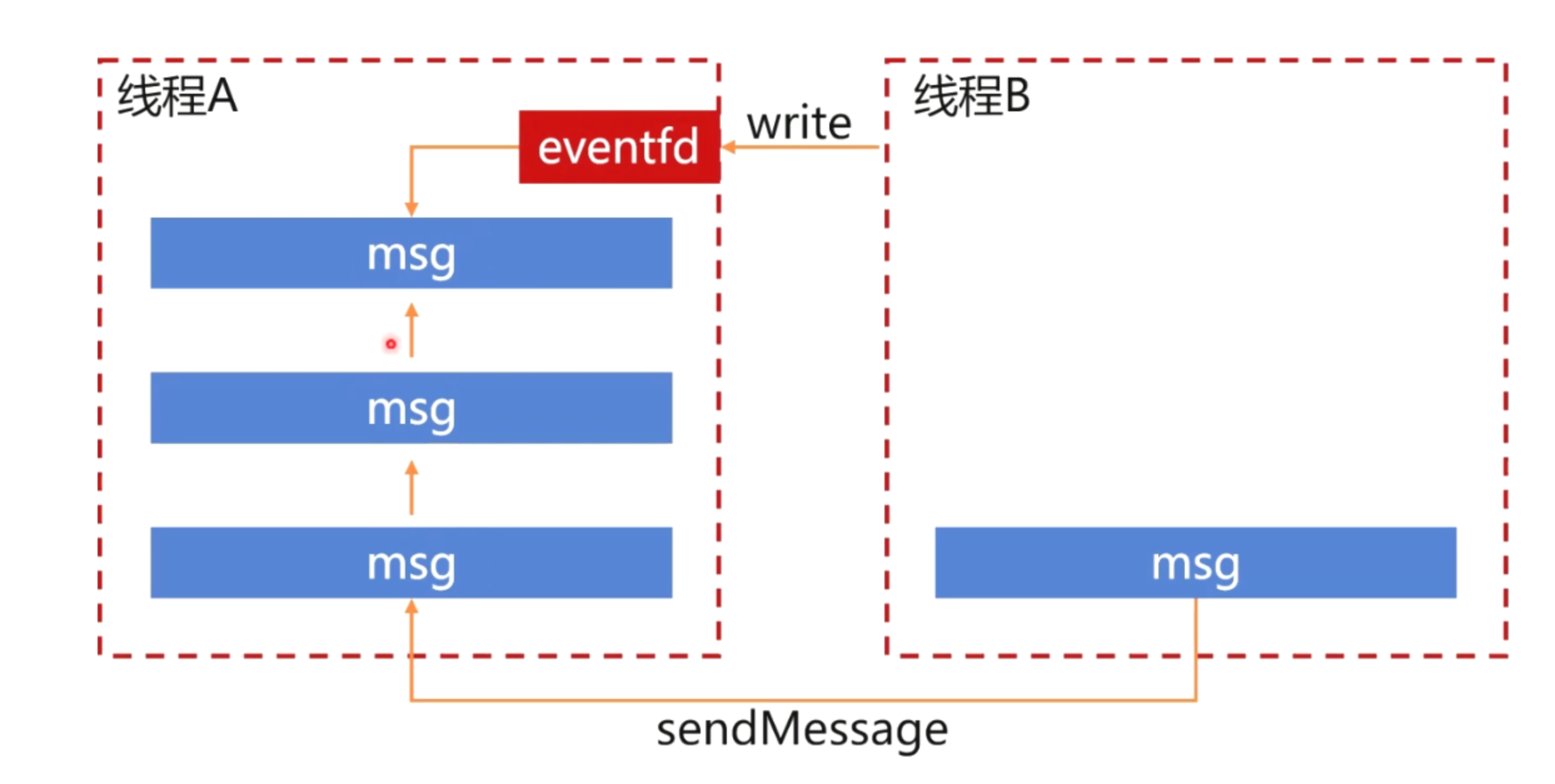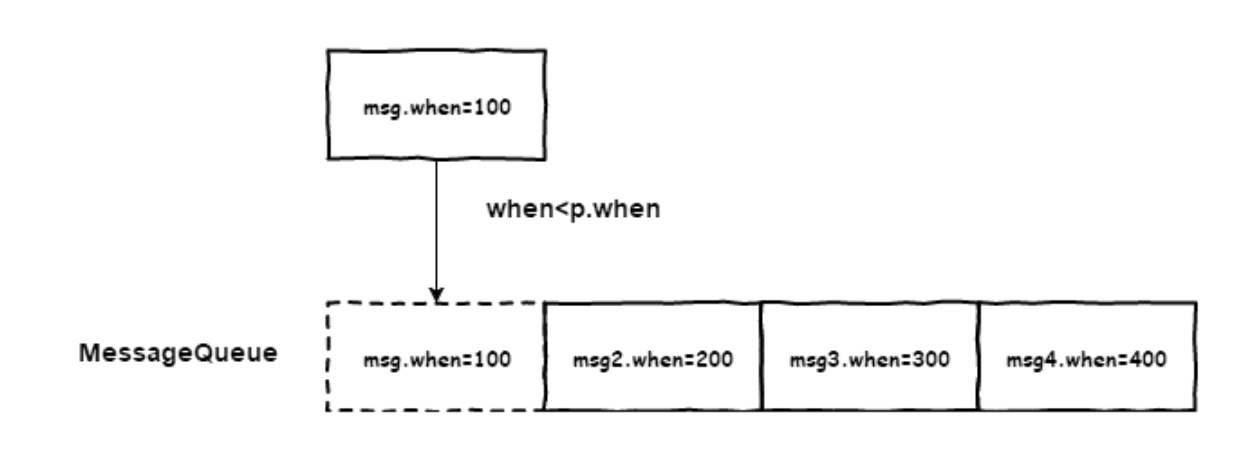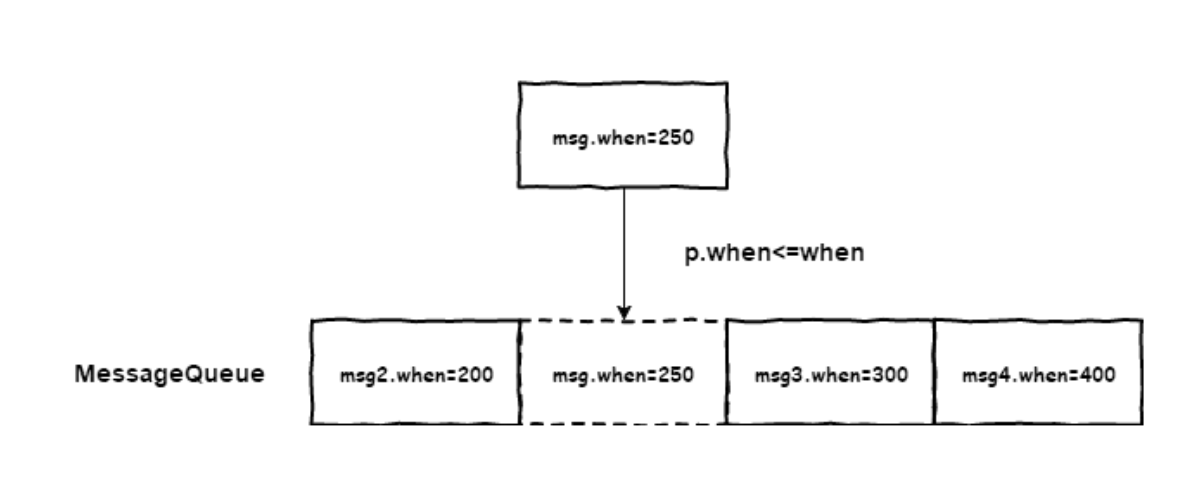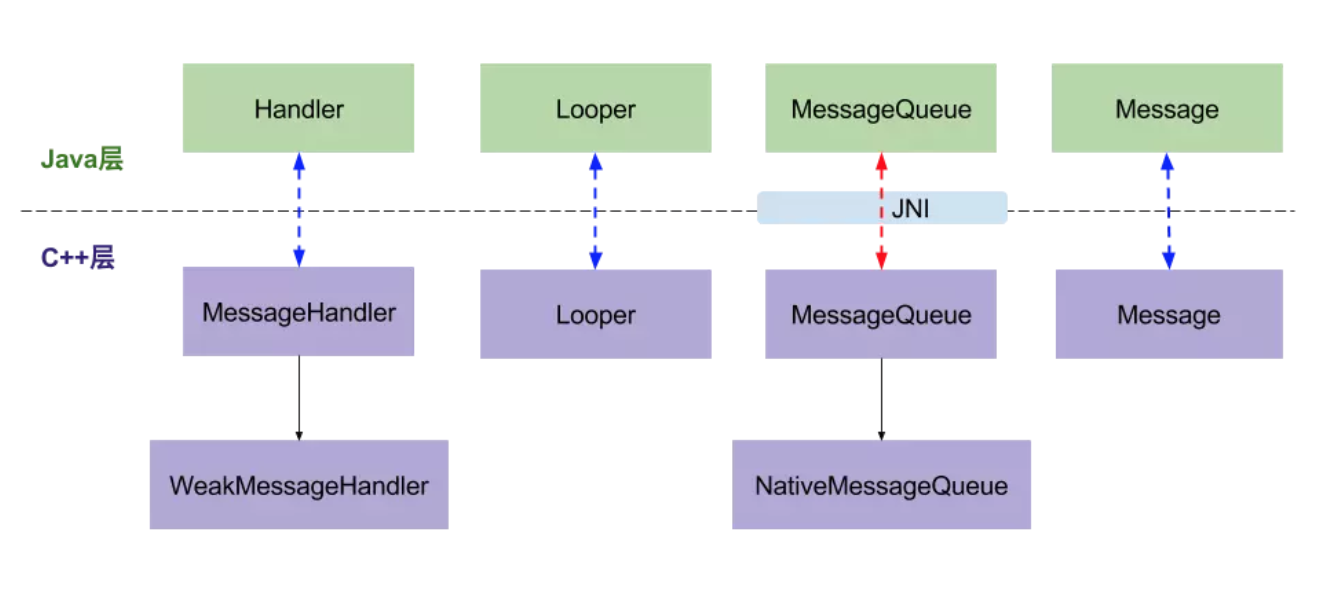线程间消息传递机制
http://androidxref.com/6.0.1_r10/xref/frameworks/base/core/java/android/os/Handler.java
http://androidxref.com/6.0.1_r10/xref/frameworks/base/core/java/android/os/MessageQueue.java
http://androidxref.com/6.0.1_r10/xref/frameworks/base/core/java/android/os/Looper.java
http://androidxref.com/6.0.1_r10/xref/frameworks/base/core/java/android/os/Message.java

1.消息怎么发送的?
我们都知道当调用Handler发送消息的时候,不管是调用
sendMessage,sendEmptyMessage,sendMessageDelayed还是其他发送一系列方法。最终都会调用sendMessageDelayed(Message msg, long delayMillis)方法。
public final boolean sendMessageDelayed(Message msg, long delayMillis) { if (delayMillis < 0) { delayMillis = 0; } return sendMessageAtTime(msg, SystemClock.uptimeMillis() + delayMillis); }
public boolean sendMessageAtTime(Message msg, long uptimeMillis) { MessageQueue queue = mQueue; if (queue == null) { RuntimeException e = new RuntimeException( this + " sendMessageAtTime() called with no mQueue"); Log.w("Looper", e.getMessage(), e); return false; } return enqueueMessage(queue, msg, uptimeMillis); }
private boolean enqueueMessage(MessageQueue queue, Message msg, long uptimeMillis) { msg.target = this; if (mAsynchronous) { msg.setAsynchronous(true); } return queue.enqueueMessage(msg, uptimeMillis); }
消息的加入
boolean enqueueMessage(Message msg, long when) { if (msg.target == null) { throw new IllegalArgumentException("Message must have a target."); } if (msg.isInUse()) { throw new IllegalStateException(msg + " This message is already in use."); } synchronized (this) { //如果当前消息循环已经结束,直接退出 if (mQuitting) { IllegalStateException e = new IllegalStateException( msg.target + " sending message to a Handler on a dead thread"); Log.w(TAG, e.getMessage(), e); msg.recycle(); return false; } msg.markInUse(); msg.when = when; Message p = mMessages;//头部消息 boolean needWake; //如果队列中没有消息,或者当前进入的消息比消息队列中的消息等待时间短,那么就放在消息队列的头部 if (p == null || when == 0 || when < p.when) { // New head, wake up the event queue if blocked. msg.next = p; mMessages = msg; needWake = mBlocked; } else { //判断唤醒条件,当前当前消息队列头部消息是屏障消息,且当前插入的消息为异步消息 //且当前消息队列处于无消息可处理的状态 needWake = mBlocked && p.target == null && msg.isAsynchronous(); Message prev; //循环遍历消息队列,把当前进入的消息放入合适的位置(比较等待时间) for (;;) { prev = p; p = p.next; if (p == null || when < p.when) { break; } if (needWake && p.isAsynchronous()) { needWake = false; } } //将消息插入合适的位置 msg.next = p; prev.next = msg; } //调用nativeWake,以触发nativePollOnce函数结束等待 if (needWake) { nativeWake(mPtr); } } return true; }
这里大家肯定注意到了nativeWake()方法,这里先不对该方法进行详细的描述,下文会对其解释及介绍。 其实通过代码大家就应该发现了,在将消息加入到消息队列中时,已经将消息按照等待时间进行了排序。排序分为两种情况(这里图中的message.when是与当前的系统的时间差):
- 第一种:如果队列中没有消息,或者当前进入的消息比消息队列中头部的消息等待时间短,那么就放在消息队列的头部

第二种:反之,循环遍历消息队列,把当前进入的消息放入合适的位置(比较等待时间)

综上,我们了解了在我们使用Handler发送消息时,当消息进入到MessageQueue(消息队列)中时,已经按照等待时间进行了排序,且其头部对应的消息是Loop即将取出的消息
android_os_MessageQueue_nativeWake
static void android_os_MessageQueue_nativeWake(JNIEnv* env, jclass clazz, jlong ptr) { NativeMessageQueue* nativeMessageQueue = reinterpret_cast<NativeMessageQueue*>(ptr); nativeMessageQueue->wake(); }
和之前一样,也是通过long类型的ptr获取NativeMessageQueue对象的指针,再调用wake方法
void NativeMessageQueue::wake() { mLooper->wake(); }
调用的也是Looper的方法:
void Looper::wake() { uint64_t inc = 1; ssize_t nWrite = TEMP_FAILURE_RETRY(write(mWakeEventFd, &inc, sizeof(uint64_t))); if (nWrite != sizeof(uint64_t)) { if (errno != EAGAIN) { ALOGW("Could not write wake signal: %s", strerror(errno)); } } }
重点是write(mWakeEventFd, &inc, sizeof(uint64_t)),写入了一个1,这个时候epoll就能监听到事件,也就被唤醒了
2.怎么样进行消息循环
public static void loop() { final Looper me = myLooper(); if (me == null) { throw new RuntimeException("No Looper; Looper.prepare() wasn't called on this thread."); } final MessageQueue queue = me.mQueue; //... for (;;) { Message msg = queue.next(); // might block if (msg == null) { // No message indicates that the message queue is quitting. return; } //... try { msg.target.dispatchMessage(msg); if (observer != null) { observer.messageDispatched(token, msg); } dispatchEnd = needEndTime ? SystemClock.uptimeMillis() : 0; } catch (Exception exception) { //... } finally { //... } //... msg.recycleUnchecked(); } }
从MessageQueue获取下一条消息
1.如果是null,退出
2.如果不为null,dispatchMessage
怎么处理消费的分发过程?
public void dispatchMessage(Message msg){ //检查message的callback是否为null if(msg.calllback!=null){ handleCallback(msg); } else{ if(mCallback!=null){ if(mCallback.handleMessage(mssg)){//主意如果这个返回值是true 将不会执行下面的handlerMessage return; } } handleMessage(msg); } }
首先,检查Message的callback是否为null,不为空就通过handleCallback来处理消息。message的callback是一个Runnbale对象,实际上就是Handler的post方法所传递的Runnable参数。
private static void handleCallback(Message message){ message.callback.run(); }
其次,检查mCallback是否为空,不为null及调用mCallback的handleMessage方法来处理消息
public interface Callback{ public boolean handleMessage(Message msg); }
MessageQueue的next方法
Message next() { //... int nextPollTimeoutMillis = 0; for (;;) { if (nextPollTimeoutMillis != 0) { Binder.flushPendingCommands(); } //执行native层消息机制层, //timeOutMillis参数为超时等待时间。如果为-1,则表示无限等待,直到有事件发生为止。 //如果值为0,则无需等待立即返回。该方法可能会阻塞 nativePollOnce(ptr, nextPollTimeoutMillis); synchronized (this) { //获取系统开机到现在的时间,如果使用System.currentMillis()会有误差, final long now = SystemClock.uptimeMillis(); Message prevMsg = null; Message msg = mMessages;//头部消息 //判断是否是栅栏,同时获取消息队列最近的异步消息 if (msg != null && msg.target == null) { do { prevMsg = msg; msg = msg.next; } while (msg != null && !msg.isAsynchronous()); } msg.next = null; if (DEBUG) Log.v(TAG, "Returning message: " + msg); msg.markInUse(); return msg; //... } }

Message next() { //如果退出消息消息循环,那么就直接退出 final long ptr = mPtr; if (ptr == 0) { return null; } int pendingIdleHandlerCount = -1; // -1 only during first iteration int nextPollTimeoutMillis = 0; for (;;) { if (nextPollTimeoutMillis != 0) { Binder.flushPendingCommands(); } //执行native层消息机制层, //timeOutMillis参数为超时等待时间。如果为-1,则表示无限等待,直到有事件发生为止。 //如果值为0,则无需等待立即返回。该方法可能会阻塞 nativePollOnce(ptr, nextPollTimeoutMillis); synchronized (this) { //获取系统开机到现在的时间,如果使用System.currentMillis()会有误差, final long now = SystemClock.uptimeMillis(); Message prevMsg = null; Message msg = mMessages;//头部消息 //判断是否是栅栏,同时获取消息队列最近的异步消息 if (msg != null && msg.target == null) { do { prevMsg = msg; msg = msg.next; } while (msg != null && !msg.isAsynchronous()); } //获取消息,判断等待时间,如果还需要等待则等待相应时间后唤醒 if (msg != null) { if (now < msg.when) {//判断当前消息时间,是不是比当前时间大,计算时间差 // Next message is not ready. Set a timeout to wake up when it is ready. nextPollTimeoutMillis = (int) Math.min(msg.when - now, Integer.MAX_VALUE); } else { // 不需要等待时间或者等待时间已经到了,那么直接返回该消息 mBlocked = false; if (prevMsg != null) { prevMsg.next = msg.next; } else { mMessages = msg.next; } msg.next = null; if (DEBUG) Log.v(TAG, "Returning message: " + msg); msg.markInUse(); return msg; } } else { //没有更多的消息了 nextPollTimeoutMillis = -1; } // Process the quit message now that all pending messages have been handled. //判断是否已经退出了 if (mQuitting) { dispose(); return null; } // If first time idle, then get the number of idlers to run. // Idle handles only run if the queue is empty or if the first message // in the queue (possibly a barrier) is due to be handled in the future. //获取空闲时处理任务的handler 用于发现线程何时阻塞等待更多消息的回调接口。 if (pendingIdleHandlerCount < 0 && (mMessages == null || now < mMessages.when)) { pendingIdleHandlerCount = mIdleHandlers.size(); } //如果空闲时处理任务的handler个数为0,继续让线程阻塞 if (pendingIdleHandlerCount <= 0) { // No idle handlers to run. Loop and wait some more. mBlocked = true; continue; } //判断当前空闲时处理任务的handler是否是为空 if (mPendingIdleHandlers == null) { mPendingIdleHandlers = new IdleHandler[Math.max(pendingIdleHandlerCount, 4)]; } mPendingIdleHandlers = mIdleHandlers.toArray(mPendingIdleHandlers); } //只有第一次迭代的时候,才会执行下面代码 for (int i = 0; i < pendingIdleHandlerCount; i++) { final IdleHandler idler = mPendingIdleHandlers[i]; mPendingIdleHandlers[i] = null; // release the reference to the handler boolean keep = false; try { keep = idler.queueIdle(); } catch (Throwable t) { Log.wtf(TAG, "IdleHandler threw exception", t); } //如果不保存空闲任务,执行完成后直接删除 if (!keep) { synchronized (this) { mIdleHandlers.remove(idler); } } } // 重置空闲的handler个数,因为不需要重复执行 pendingIdleHandlerCount = 0; //当执行完空闲的handler的时候,新的native消息可能会进入,所以唤醒Native消息机制层 nextPollTimeoutMillis = 0; } }
Native消息机制
其实在Android 消息处理机制中,不仅包括了Java层的消息机制处理,还包括了Native消息处理机制(与我们知道的Handler机制一样,也拥有Handler、Looper、MessageQueue)。这里我们不讲Native消息机制的具体代码细节,如果有兴趣的小伙伴,请查看----->深入理解Java Binder和MessageQueue
这里我们用一张图来表示Native消息与Jave层消息的关系(这里为大家提供了Android源码,大家可以按需下载),具体细节如下图所示:

static void android_os_MessageQueue_nativePollOnce(JNIEnv* env, jobject obj, jlong ptr, jint timeoutMillis) { NativeMessageQueue* nativeMessageQueue = reinterpret_cast<NativeMessageQueue*>(ptr); nativeMessageQueue->pollOnce(env, obj, timeoutMillis); }
在nativePollOnce()方法中调用nativeMessageQueue的pollOnce()方法,我们接着走。
void NativeMessageQueue::pollOnce(JNIEnv* env, jobject pollObj, int timeoutMillis) { mPollEnv = env; mPollObj = pollObj; mLooper->pollOnce(timeoutMillis); mPollObj = NULL; mPollEnv = NULL; if (mExceptionObj) { env->Throw(mExceptionObj); env->DeleteLocalRef(mExceptionObj); mExceptionObj = NULL; } }
int Looper::pollOnce(int timeoutMillis, int* outFd, int* outEvents, void** outData) { int result = 0; for (;;) { // 先处理没有Callback方法的 Response事件 while (mResponseIndex < mResponses.size()) { const Response& response = mResponses.itemAt(mResponseIndex++); int ident = response.request.ident; if (ident >= 0) { //ident大于0,则表示没有callback, 因为POLL_CALLBACK = -2, int fd = response.request.fd; int events = response.events; void* data = response.request.data; if (outFd != NULL) *outFd = fd; if (outEvents != NULL) *outEvents = events; if (outData != NULL) *outData = data; return ident; } } if (result != 0) { if (outFd != NULL) *outFd = 0; if (outEvents != NULL) *outEvents = 0; if (outData != NULL) *outData = NULL; return result; } // 再处理内部轮询 result = pollInner(timeoutMillis); } }
nativePollOnce()一直循环为毛不造成主线程的卡死?
